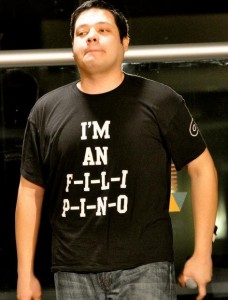Young FilAms connect with the past
By Cristina DC PastorFrisky 3-a-half-year-old George Haines came into the Singgalot cultural show with his American dad and Filipino mom.
“You can’t be Filipino,” I cracked a lame joke hoping to get his attention and take his photo wearing a ‘Pinoy’ shirt in Sheldon Cooper fashion. He coyly buried his smiling face into his mother’s body.
His parents said George can point out the Philippines on a map and knows the country is somewhere close to Thailand and India. This bright-eyed toddler would later join the chatter and said Philippines “is where lolo lives.”
George was probably the youngest visitor to the Smithsonian traveling exhibit called “Singgalot — the ties that bind: Filipinos in America from colonial subjects to citizens” that day.
On March 8, the day The FilAm came to visit, Stony Brook University’s Charles B. Wang Center in Long Island was crawling with Filipino families and youngsters coming in groups to view the photographs and learn more about Philippine history – the history of their parents’ or at least one of them.
The exhibit traces the beginning of Filipino migration from the time Filipino sailors landed in the 1600s to the present and how Filipino Americans have broken the barriers of poverty, language and race to become accomplished achievers in American society. As the visitors moved from one photograph to another, sharing thoughts and emotional recollections with their families, the music of Broadway actress Lea Salonga played on a video monitor.
Grace Brosi, 8, and her brother Sage, 10, came to Singgalot with their mother. The youngsters said they came to “learn about our culture.” Nurse practitioner Maria Bune said her kids are proud to be Filipino and keep themselves informed about the Philippines via TFC. They watch the variety shows, the soap operas as well as the news. The floodings and other natural disasters are especially riveting to Sage.“I want to know what’s happening to the Filipino people when there’s a hurricane,” he said.
Before we parted, Sage suggested we call him by his Filipino nickname, “Saging” (banana).
Stony Brook student Adam Sue came to report on the event for the Asian American E-zine, of which he is the editor. The son of a Filipino mother and a Chinese father, Adam speaks neither Tagalog nor Chinese, but happily confessed to adoring the cuisine of both cultures. He said SBU has a lot of Filipino students, and Singgalot is “great way to promote cultural awareness.”
The program featured hip hop musician Koba, a Filipino rap artist in New York. The Bayanihan Kultural Kolektib duo sang about the exploitation of migrant workers, and a member of PUSO (Philippine United States Organization) delivered a spoken word monologue. John Jay professor Kevin Nadal, also the president of the Filipino American National Historical Society-Metro New York, emceed the program.














The ‘ungrammatical tee’ is a reference to Deep Foundation’s song “Children of the Sun” which can be found here: http://www.bakitwhy.com/videos/filipino-flash-walk-out-deep-foundations-children-sun Please watch the video and update the caption so people reading the article don’t think that Filipino t-shirt makers have terrible grammar. 🙂
Thanks, Kim. I think people will get that it’s intentional, a form of resistance.
Cristina
George Mirador Haines, that little 3 1/2 year old is one quarter Pinoy and very proud! My son, along with me and my husband, enjoyed the Singgalot celebration at SUNY Stony Brook’s Wang Center. An excellent way to celebrate Filipinos in America, and a great way to gather some Filipinos on Long Island. I am a Stony Brook alum and was a part of PUSO (Philippine United Student Organization) over 15 years ago, it is good to see that the group of Filipino students on campus is still together!
Ms. Pastor, wonderful report about Fil-Am discovering their Filipino heritage via an exhibition about Filipino American history before the founding of our nation.
Singgalot is a great project. Congratulations to the organizers. An interesting way to introduce a little of Filipino cultures to Filipino-American children.